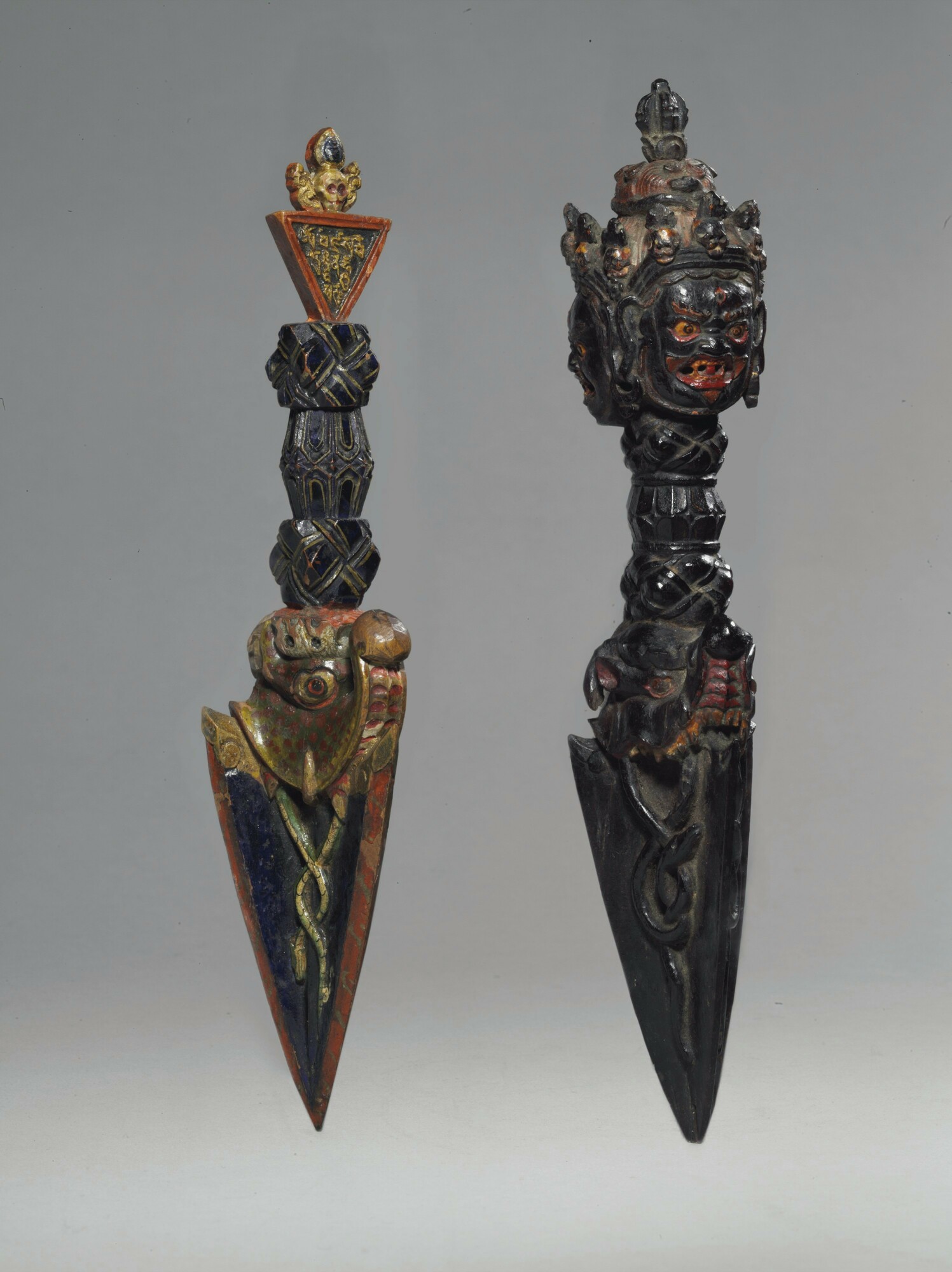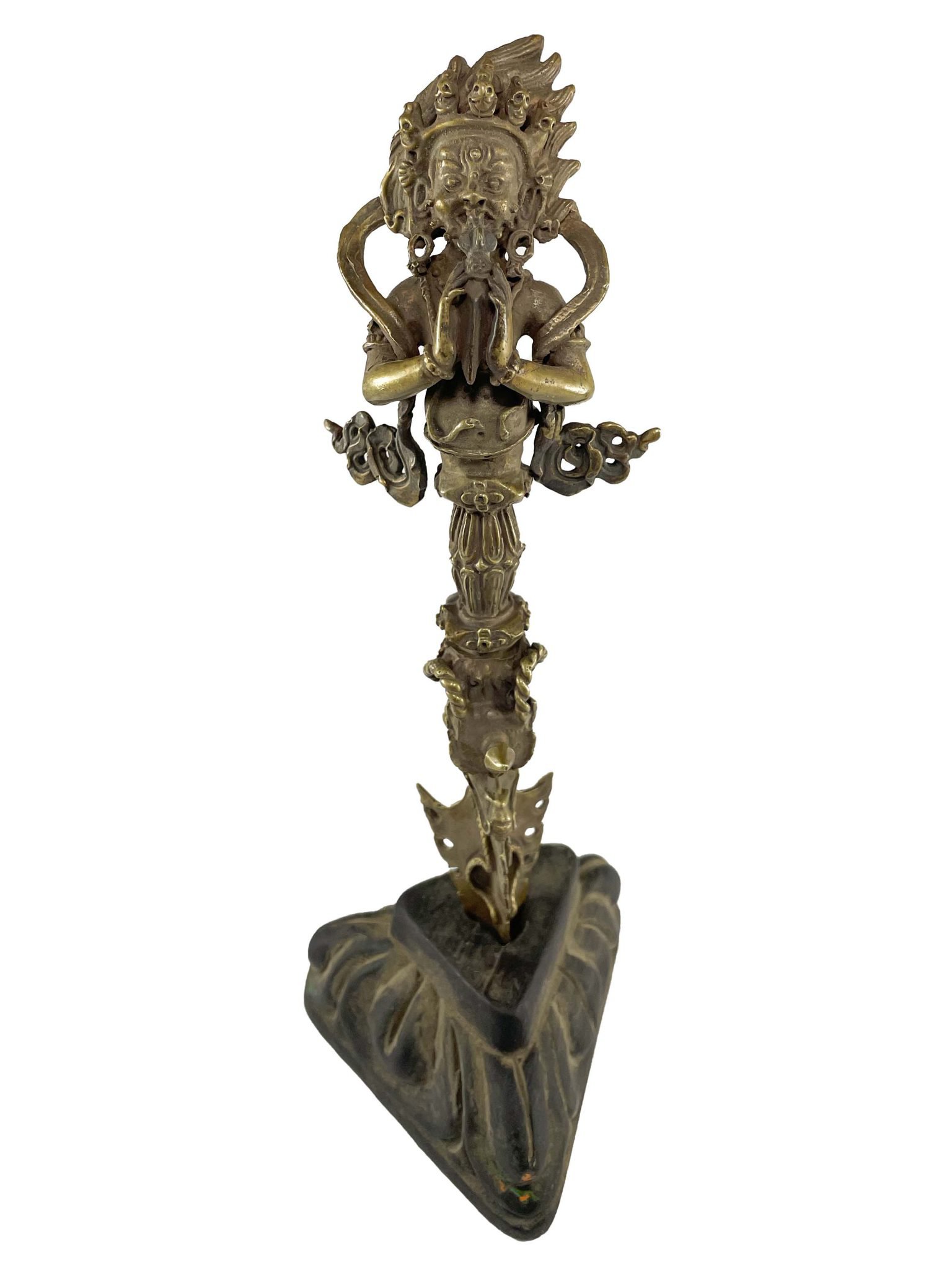The Tantric Phurba – A protective ritual dagger
The phurba is a ritual dagger used in Tantric practices. It is used to protect against negative energies and to promote positive change.
The phurba is not to be used for violence or harm, and should only be used for ritual purposes. It is a powerful tool for protection and should be used with care and respect.
Table of Contents
Origin of Phurba in Tibet
The renowned Buddhist master Padmasambhava, who was initiated by the Indian sage Prabhahastin, is said to have brought Phurba to Tibet in the year 747. 9th–10th century.
A Tibetan text was discovered at Dunhuang, China stating that during the time of Padmasambhava, the Phurba was first used in his tantric teachings, which are all focused on Dorje Phurba (Vajrakilaya).
Description of the Phurba
It is a 3 edged peg usually made from metal or wood. They are sometimes described as daggers with three blades.
Phurbas are usually made of metal, but can also be made of wood, bone, or other materials which has three blades, and each blades representing a different aspect of the Buddha’s teachings.
The best of the metal ones from a Tantric Buddhist point of view are constructed from meteorite iron. Sandalwood is also popular.



The phurba is usually decorated with images of the Buddha, bodhisattvas, or other religious figure and are kept in a shrine or temple, and is only used by monks or priests.
Various ritual texts may also specify a specific substance or medium for the specialized magical application.
These phurbas generally have three faces at the top and are crowned with a half vajra.
The Hayagriva Phurba
A specific type of phurba is connected with the practice of Hayagriva.
This purba has a horse head at the top rather than a half vajra, although it should be noted that in Hayagriva’s iconographic depictions he does not hold a phurba.
The Nyingma lamas Dorje Dudjom and Jatson Nyingpo are generally shown with the left hand thrusting a phurba downward.
The Bon Phurba
The Bon shamanism also uses the phurba as a ritual object.
These Bon ritual Phurbas can generally be identified as having multiple heads with the top crowned with a garuda – the king of birds along with a total absence of a full or half vajra.
Types of Phurbas and usage
The phurba is used to protect against evil spirits and to exorcise them from people or places. It is also used compel the evil spirits so they can be destroyed.
The phurba is a reminder that we are all connected, and that we should act with compassion and kindness towards all beings and that Buddha is always with us, and that we can always turn to him for guidance and support.
Phurbas are ritual objects that come in a variety of shapes and metals, typically without a face. The three general categories of phurba are:
- Recitation phurba: Support for Vajrakilaya or Hayagriva practice, to be kept on the shrine
- Activity phurba: For performing various activities during development stage practice, e.g. liberation offering during feast (tsok) offerings.
- Protection: For carrying around to protect oneself from harmful obstacles
Additionally, there are various varieties of phurba. Faces are typically displayed as a devotional object on an altar.
Lamas may hold the Phurba during various rituals, such as a “blessing,” but typically the face is covered metaphorically with cloth in these circumstances.
Alternatively the dagger would be stuck in the ground to mark the place for the composition of a mandala.
Iconographic elements of the Phurba
The blade generally has a triangular form comprising of three sides, on which are representations of snakes (naga in Sanskrit, klu in Tibetan) either on their own or entwined in pairs.
They have the power to make it rain and are the guardians of water, the underworld and treasure.



The triple Blades
The blade bursts forth from the jaws of a water dragon, a monster half crocodile and half elephant, reputed to have originated in the sea.
The water Dragon is also called makara in Sanskrit or chu-srin in Tibetan.
Sometimes the makara is replaced by a geometric figure or by another animal such as the mythical bird garuda (khyung in Tibetan), the mortal enemy of the naga and protector against illness.
The body of the Phurba
The body is most often a handle representing or evoking the shape of a “thunderboltdiamond” (vajra in Sanskrit rdo-rje in Tibetan) but this can be replaced by an object of polyhedral form that is sometimes decorated with stylized lotus leaves.
This element symbolises the power and strength of the doctrines and practices of tantric Buddhism.



The vajra or object is held in place by ‘eternal knots’ (equally called ‘Chinese knots’, rgya-mdud in Tibetan) of diverse forms, balls or tetrahedron, these imitate the cloth knots used to hold the “ incandescent weapon” and on another level are a symbol of longevity and of the cycle of rebirth.
The three faces head
The head is of various forms according to the deity represented. The most common form is that of three identical faces, one peaceful (parted lips), one joyful (teeth visible) and one wrathful (tongue showing).
The three faces symbolize the three bodies of Buddha or the victory over the three poisons (ignorance, desire, and hate).
The faces are generally grouped together under a communal headdress and the phurba is completed by a knot at the top of the head, a half-vajra, or an attribute of the deity represented or a ring.
In certain cases, the three faces are replaced by the head of an animal (bird, bull, dog, snake…) In general these are representations of minor deities, considered as guardians of the tantric way or vehicle.
The Vajrakilaya Tantra
The principal deity associated with the purba is Vajrakila in his winged form. The divinity also called Dorje Drolo in Tibetan, is shown half-length in various positions (hands joined, with or without attributes), the legs being replaced by the blade.



The Vajrakilaya Tantra is a system of practice perfected and passed down by the deified historical figure Padmasambhava, who is credited with bringing Buddhism to Tibet in the eighth century and dedicating Samye, the country’s first Buddhist monastery.
Tibetan Buddhist practitioners use this holy text along with the phurba, in the tradition started by early Vajrayana practitioners, or nyingmapa, who brought traditions from India to Tibet, to ward off demonic impediments and protect the faith.
Antique Masterpieces
Antique wrathful Heruka
This Antique Phurba with three wrathful Heruka heads represent the power of the instrument in ritual as an embodiment of the blood-drinking deity Vajrakilaya.
This big phurba was designed with the idea of an effective, yet aesthetically-impressive ceremonial implement.
It was carved from rare and expensive ebony, known in Chinese as wumu, and was previously inlaid with large earrings and rows of teeth made of ivory.
The use of pricey materials suggests that this was an imperial commission and was given to a revered Tibetan teacher as a gift by a royal court.
From museums & private collections
This is a gallery of master pieces of phurba from divers museums and private collections around the world:








A simple guided meditation
The phurba is not to be used for violence or harm, and should only be used for ritual purposes.
During rituals and meditations the Phurba is consecrated before usage and in some customs the handle might have a string wrapped around it but it can be different in other shamanic rituals.
Although the Phurba has a physical appearance, it mostly affects the mind and the spirit with its presence and force.
This is a simple guided meditation process for beginners to practice with a Phurba:
- Sit in a comfortable position with your spine straight.
- Rest your hands in your lap with your palms up.
- Hold the Phurba in your right hand.
- Focus your attention on the tip of the Phurba.
- Breathe deeply and evenly.
- Visualize the Phurba piercing through all obstacles.
- Feel the Phurba’s power and energy entering your body.
- Use the Phurba to metaphorically cut through all negative thoughts and emotions.
- Release all attachment to the results of your meditation.
- Surrender to the Phurba and the guidance it provides.
- Allow the Phurba to take you on a journey of self-discovery.
- Be open to whatever insights and revelations you receive.
- Trust that the Phurba will lead you to your highest good.
- Follow your intuition and let the Phurba guide your actions.
- Be fearless in your pursuit of your most important life goal.
- Use the Phurba to metaphorically cut through all your self-imposed limitations.
- Allow the Phurba to empower you to reach your most important life goal.












